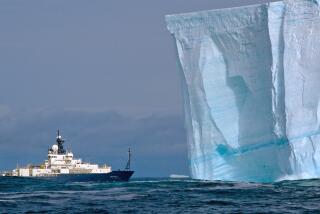‘Gondwana’ reveals the stunning beauty, mystery of Antarctica
- Share via
When photographer Diane Tuft arrived on Antarctica in October 2012, she found a sky swirling with tiny ice crystals called diamond dust. She saw wind-shaped dunes of snow, glacial formations that looked like the Mojave, frozen in a moment. She spied “snow flowers,” volcanic gas formations that she likened to three-dimensional lace, and she turned her lens to sheets of ice dotted with bubbles and silt, multihued compositions that could be mistaken for abstract paintings. One of her photographs captures stark white bubbles streaked against dark-as-night frozen waters — an image that seems from outer space, an asteroid field in miniature.
Otherworldly is just one of the words for Tuft’s book of Antarctic photography, “Gondwana — Images of an Ancient Land” [Assouline, $95], which not only shares an artist’s eye but also a conservationist’s plea.
Tuft’s earlier studies of ultraviolet and infrared light led to a 2012 National Science Foundation grant that allowed her to explore “hidden light” in Antarctica. A depleted ozone layer over this frozen frontier means that more ultraviolet light reaches Earth’s surface, Tuft writes, manifesting itself in ultraviolet colors in the snow and intense blue shadows.
Some of her images are disorienting at first. Ambiguous in scale, they reveal few clues of what exactly you’re seeing. But taken as a whole, the book makes these abstractions a highlight. Readers may walk away with not just photographic representations of landscapes but also the ethereal experience of being there — or as close as many of us ever will get.
“Since it only snows five inches per year in Antarctica, most of the snow represents millions of years of accumulation, resulting in snow patterns totally different from those you find anywhere else in the world,” writes the New York-based photographer. That is another virtue of “Gondwana”: Digital technology, satellite imagery, Facebook and Instagram have made seeing and sharing the enthralling beauty at the deepest ends of the Earth so easy, that sense of discovery has become all too rare. Tuft aims to provide that feeling of exploration, closing her book with images captured on high-speed infrared film.
Infrared light waves, she explains, are beyond humans’ visible spectrum but appear on film as they are reflected and absorbed by the landscape. Lurking in the pixels of these black-and-white pictures is the reality of rising carbon dioxide levels and increased infrared light reaching Earth’s surface. It’s here where the beauty and mystery of Antarctica in “Gondwana” turns haunting, the images like X-rays of a planet’s health, in flux.
Twitter: @cnakano
More to Read
The biggest entertainment stories
Get our big stories about Hollywood, film, television, music, arts, culture and more right in your inbox as soon as they publish.
You may occasionally receive promotional content from the Los Angeles Times.











